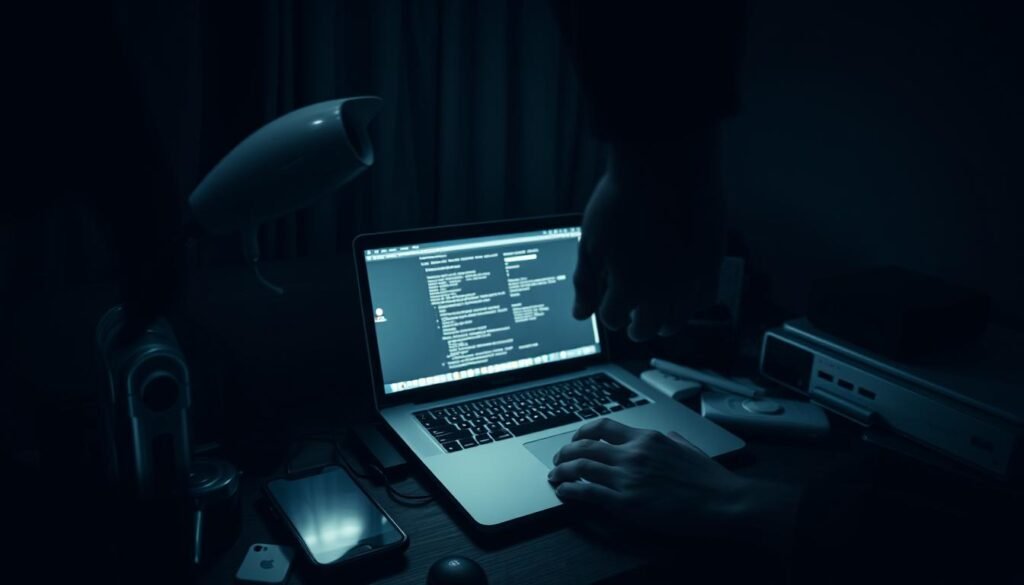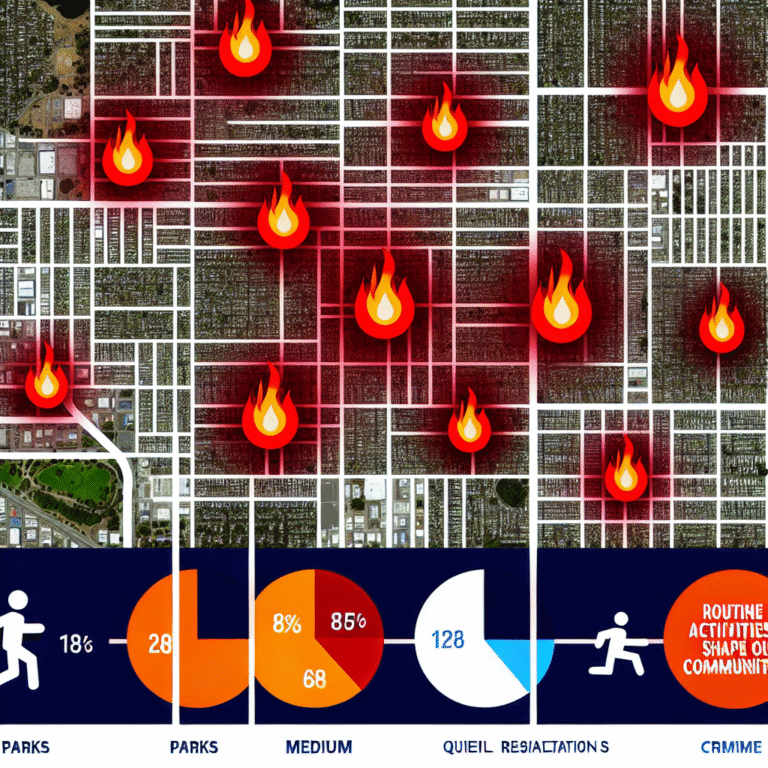
Can technology that’s meant to make our lives easier actually harm us? The misuse of tracking devices like AirTags and spyware is a growing concern. There are more reports of digital stalking and harassment.
As we use more smart technology, the line between convenience and danger gets fuzzy. Cyberstalking is a big worry now. We need to look closely at the risks and how to stay safe.
Key Takeaways
- Understanding the risks associated with the misuse of tracking devices and spyware.
- Recognizing the signs of digital stalking and harassment.
- Exploring safety plans and measures to mitigate these risks.
- The importance of balancing convenience and security in the use of smart technology.
- Strategies for protecting personal privacy and security.
The Rising Threat of Tech-Facilitated Stalking
Advanced tracking devices like AirTags have made stalking easier. Now, stalkers can track people without their consent. This has raised concerns among law enforcement and cybersecurity experts.
Statistics and Prevalence in the United States
Stalking cases using technology have increased. The National Institute of Justice found in 2020, about 1 in 3 women and 1 in 7 men were stalked. Technology in stalking is now a major concern.
| Year | Reported Stalking Cases | Cases Involving Technology |
|---|---|---|
| 2018 | 1,000,000 | 200,000 |
| 2019 | 1,100,000 | 250,000 |
| 2020 | 1,200,000 | 300,000 |
Evolution from Traditional to Digital Stalking
Stalking has changed with technology. Old methods are now replaced by digital ones. This makes it easier for stalkers to watch their victims.
The main differences are in anonymity and access to personal info. Digital stalking is more dangerous because of these factors.
Key Differences and Increased Dangers
Digital stalking is more dangerous because stalkers can stay hidden. They can use spyware and tracking devices to watch their victims without being seen.
Key differences include:
- Anonymity: Digital stalkers can hide behind fake profiles and anonymous accounts.
- Access to personal data: Stalkers can easily access personal information online.
- Surveillance capabilities: Spyware and tracking devices enable stalkers to monitor victims’ activities.

Understanding the Psychology Behind Digital Stalking
It’s key to understand the psychology of digital stalking to stop it. Digital stalking uses technology to control or harass people. It’s a serious issue.
Motivations of Tech Stalkers
Stalkers use tech to control their victims. Their reasons vary from obsession to revenge. The internet makes it easier for them to track and harass.
There are many reasons why people stalk online:
- Obsession: Some stalkers want to be close to their victims. They use tech to watch their every step.
- Revenge: Others stalk online to harm or upset their victims.
- Control: Many stalkers want to control their victim’s life. They use tech to watch and limit their freedom.
Common Patterns and Behaviors
Digital stalkers often follow certain patterns. They might:
- Watch their victim’s online activities.
- Track their victim’s location with GPS.
- Send scary or mean messages.
These actions can be sneaky. It’s hard for victims to know they’re being stalked.
Warning Signs in Relationships
Spotting warning signs in relationships is important. Look out for:
- Too many questions about where someone is or what they’re doing.
- Checking someone’s digital messages without permission.
- Feeling very jealous or possessive.

How Everyday Technology Becomes a Stalking Tool
Once safe and secure, everyday devices are now used by stalkers. They use technology to watch and harass their victims. This shows we need to be aware and careful.
Smartphones and Tablets
Smartphones and tablets are often used in digital stalking. Stalkers can install spyware or tracking apps. This lets them see where their victim is, what they’re saying, and what they’re doing without them knowing.
Smart Home Devices
Stalkers can also hack into smart home devices. This includes voice assistants and security cameras. It’s important to keep these devices safe to stop misuse.
Wearable Technology
Wearable tech like smartwatches and fitness trackers can track a victim’s location. It can also monitor their health and activity. This lets stalkers control their victim’s life.
Vehicle Tracking Systems
Modern cars have tracking systems. Stalkers might use these to follow their victims. We need to be aware and take steps to protect ourselves.
| Device | Potential Misuse | Protective Measures |
|---|---|---|
| Smartphones/Tablets | Spyware installation, location tracking | Regularly update OS, use anti-spyware software |
| Smart Home Devices | Unauthorized access, surveillance | Secure passwords, update firmware regularly |
| Wearable Technology | Location tracking, health data monitoring | Limit shared data, use strong passwords |
| Vehicle Tracking Systems | Movement tracking | Regularly check for unauthorized tracking devices |

The AirTag Threat: How Trackers Enable Stalking
AirTags were meant to help find lost items. But, they’ve become a tool for stalkers. These small devices use Bluetooth to track items, which can be misused to follow someone’s movements.
How AirTags and Similar Devices Work
AirTags use Bluetooth to connect with Apple devices. They send their location to the owner’s iCloud. This helps find lost items but can also be used for bad purposes.
Real-world Cases of AirTag Stalking
There are cases where AirTags were used to stalk people. For example, someone might hide an AirTag in a victim’s car. This shows the importance of being aware and taking steps to prevent it.
| Case Type | Description | Prevention Measure |
|---|---|---|
| Hidden in Personal Items | Stalker hides AirTag in victim’s belongings | Regularly check for unknown AirTags |
| Vehicle Tracking | AirTag placed in or on the victim’s vehicle | Inspect vehicle regularly for AirTags |
Apple’s Safety Features and Their Limitations
Apple has added safety features to AirTags. These include alerts for unknown AirTags. But, these features might not always stop stalking.
Finding Unknown AirTags Near You
To find unknown AirTags, open the ‘Find My’ app. Go to ‘Items’ and look for ‘Items Detected Near You.’ If you find an unknown AirTag, tap on it for more info and to disable it.
Knowing how AirTags work and their misuse can help protect against stalking. It’s important to stay informed and take action to stay safe.
Spyware and Monitoring Apps: The Invisible Threat
In today’s world of smart-tech, spyware and monitoring apps are big threats to our safety. These tools are often used for good, like keeping an eye on kids or employees. But, stalkers can misuse them to secretly watch someone’s online life.
Types of Surveillance Software
There are many kinds of spyware, like keyloggers, screen capture tools, and GPS trackers. These can watch what you do, grab private info, and even track where you are.
How Stalkers Deploy Spyware
Stalkers might use spyware by finding weak spots in your device or by tricking you into installing it. Once it’s on, spyware can hide well, making it hard to find.
Signs Your Device Has Been Compromised
There are clues your device might have spyware. Look out for things like your battery draining fast, using more data than usual, or your device acting weird.
Common Entry Points for Spyware
Spyware usually gets in through phishing emails, bad downloads, or weak spots in security. Keeping your device and apps updated is key to avoiding these problems.
| Signs of Spyware Infection | Description | Action to Take |
|---|---|---|
| Unusual Battery Drain | Device battery drains faster than usual | Check for malicious apps, update OS |
| Unexpected Data Usage | Noticeable increase in data consumption | Review data usage patterns, uninstall suspicious apps |
| Strange Device Behavior | Random reboots, unfamiliar apps | Run a security scan, reset device if necessary |
To fight spyware, be careful with app downloads and avoid dodgy links. Also, keep your device’s security up-to-date. Being alert and informed can help keep you safe from digital stalking.
Social Media Exploitation in Stalking Cases
Social media is now a big part of our lives. It’s also a tool for stalkers to track and harass people. They use different features on social media to do this.
Location Tagging Dangers
Location tagging is a big risk on social media. When you tag your location, you share where you are. This can be dangerous because stalkers can find you.
To stay safe, don’t share your location too much. Only let trusted people see where you are. This can help keep you from being tracked.
Information Mining from Posts
Stalkers can learn a lot from what you post online. They can find out about your life, routines, and who you know. This makes it easy for them to create a profile on you.
“The more you share online, the more you’re at risk of being tracked or stalked. It’s important to think about what you post and who sees it.”
Fake Profiles and Catfishing
Stalkers also make fake profiles to get information or trick people. These fake profiles can be used to befriend you and get personal details from you.
Privacy Setting Tutorials
To stay safe, you need to know how to use privacy settings on social media. Here are some tips:
- Check and change your privacy settings often.
- Share less personal information.
- Be careful who you friend online.
| Platform | Privacy Setting Tips |
|---|---|
| Use “Friends” or “Friends except acquaintances” for sensitive posts. | |
| Set account to private and be cautious with location tags. | |
| Control who can see your tweets and protect your tweets. |
By knowing these risks and taking steps to protect yourself online, you can lower your chance of being stalked through social media.
Recognizing the Signs of Tech-Facilitated Stalking
It’s key to spot the signs of tech-facilitated stalking early. This abuse uses digital tools to track and threaten people. It leaves subtle clues that can be found.
Digital Footprints and Unexpected Encounters
People might see odd digital actions, like strange logins or messages. They could also find themselves in places unexpectedly. This could be due to tracking devices or apps that share locations.
Device Behavior Changes
Changes in how devices act can signal stalking. These signs can show up in different ways.
Battery Drain and Performance Issues
Stalkers might install spyware that eats up battery and slows devices. Victims might see their phones get hot, drain fast, or run slow.
Unusual Account Activity
Seeing odd things on personal accounts can be a red flag. This includes unexpected logins, password changes, or strange purchases. It means someone unauthorized might have accessed your accounts.
| Signs | Description |
|---|---|
| Unexplained Logins | Logging into accounts from unfamiliar locations or devices. |
| Device Slowdown | Noticing a significant decrease in device performance. |
| Rapid Battery Drain | Battery life depleting faster than usual. |
Psychological Indicators
Being stalked online can really mess with someone’s mind. They might feel anxious, scared, or like they’re always being watched. They might pull back from friends or act differently because of the stress.
Immediate Steps to Take If You Suspect Stalking
If you think someone is stalking you, act fast. Quick action is key to keeping you safe. The steps you take first can really help protect you.
Documentation Strategies
Start by documenting everything. Save messages, note incidents, and record any odd behavior. This is a vital first step.
Creating an Evidence Log
An evidence log is a great tool. It should have:
- Date and time of incidents
- Description of what happened
- Any relevant communications or messages
- Photos or videos if applicable
Keep this log safe and organized. It’s very important.
Securing Your Digital Presence
Protecting your online life is important. Here’s how:
- Change passwords for all accounts, focusing on financial and personal ones.
- Turn on two-factor authentication when you can.
- Check and adjust your privacy settings on social media and other online sites.
These steps can stop others from getting into your personal info.
When to Contact Authorities
Call the police when you feel it’s safe, or if you’re in danger. Make sure you have your evidence ready.
Safety Planning During Reporting
Think about your safety when you report stalking:
- Have a trusted friend or family member with you if possible.
- Keep your evidence log and any other important documents close by.
- Be clear and direct about what has happened.
Police are there to help. Giving them all the details will help them act fast.
Comprehensive Device Security Audit Tutorial
A thorough device security audit is key to spotting weaknesses in smartphones, computers, and smart home devices. This guide will help you strengthen your digital defenses against stalking and surveillance.
Smartphone Security Check
To keep your smartphone safe, follow these steps:
- Look for any odd apps and delete unknown ones.
- Check app permissions and limit access to personal info.
- Always update your OS and apps.
iOS-Specific Security Steps
- Turn on two-factor authentication (2FA) for your Apple ID.
- Use Face ID or Touch ID for extra security.
- Keep an eye on your device’s security settings.
Android-Specific Security Steps
- Enable Google’s Play Protect to scan for bad apps.
- Choose a strong lock screen (PIN, pattern, or fingerprint).
- Stay current with the latest security updates.
Computer and Tablet Assessment
For computers and tablets, make sure:
- Your OS and software are current.
- Antivirus software is running and updated.
- Firewalls are on to block unwanted access.
Smart Home Device Review
For smart home devices:
- Change default passwords to strong, unique ones.
- Update device firmware regularly.
- Only allow access to necessary users.
By following this detailed guide, you can greatly boost your digital security. This will help protect against digital surveillance and stalking apps.
Creating a Digital Safety Plan
Creating a strong digital safety plan is key to fight cyberstalking and online harassment. It has many layers to keep you safe.
Account Security Measures
Keeping your online accounts safe is very important. A good way to do this is by using strong passwords.
Password Management Systems
A password manager can create and keep safe passwords for all your accounts. This lowers the chance of hackers getting in. Also, turn on two-factor authentication (2FA) whenever you can. It adds more security.
Device Protection Protocols
It’s important to protect your devices from spyware and bad software. Update your operating system and apps often to fix security holes. Also, get good anti-virus software and scan your devices regularly to find and remove threats.
Emergency Response Planning
Having a plan for emergencies can really help when you’re being stalked or harassed. Know who to call and how to report problems to the police.
Trusted Contact Network
Building a network of people you can trust is very important. This should include friends, family, and professionals who can help you when you need it.
By following these steps, you can make your digital world safer. This will help you avoid tech-facilitated stalking.
Tools and Apps for Countering Digital Stalking
Digital stalking has become a big problem, leading to a need for new solutions. Tracker detection apps and anti-spyware software are now key. As technology changes, so do the ways stalkers operate. It’s vital for people to know about the tools that can keep their digital lives safe.
Tracker Detection Applications
Tracker detection apps find hidden tracking devices, like AirTags, used for stalking. They scan for Bluetooth signals from these devices. This alerts users to possible surveillance.
Anti-Spyware Solutions
Anti-spyware software is key for finding and removing spyware without your knowledge. Good anti-spyware tools protect against digital spying by spotting and removing spyware.
Installation and Configuration Guide
To get the most out of anti-spyware software, follow the right steps to install and set it up. This means keeping it updated and scanning all devices thoroughly.
Privacy-Enhancing Tools
Using privacy tools can also help fight digital stalking. Tools like VPNs, encrypted messaging apps, and privacy-focused browsers keep your online life secure.
Legal Protections Against Tech-Facilitated Stalking
The rise of tech-facilitated stalking has led to big legal changes. It’s important for victims to know about these legal protections. This knowledge helps them get the help they need.
Federal Laws and Regulations
Federal laws are key in fighting tech-facilitated stalking. The Violence Against Women Reauthorization Act of 2013 tackles cyberstalking as a form of domestic violence. The Computer Fraud and Abuse Act also helps in cases of unauthorized digital access.
State-Specific Protections
State laws add more protection, tailored to each area. Many states have laws against cyberstalking and digital abuse. These laws help in prosecuting offenders.
Obtaining Restraining Orders
Victims can get restraining orders to stop further harassment. To get one, they need to show evidence of stalking. This can include digital records and witness statements.
Digital Evidence Requirements
Digital evidence is key in stalking cases. This includes emails, text messages, GPS data, and social media posts. Keeping this evidence safe is vital for a strong case.
Knowing about these legal protections is a big step for victims. By using federal and state laws, victims can get the support and safety they need.
Working with Law Enforcement Effectively
When dealing with digital stalking, working with law enforcement is key. It helps ensure your safety and justice. You need to know how to report incidents and give the right evidence.
How to Report Digital Stalking
To report digital stalking, you must clearly share the facts. Prepare a detailed account of the stalking, including dates, times, and digital evidence.
Evidence Collection Best Practices
It’s important to collect and keep digital evidence well. This means saving emails, messages, and other digital communications.
Formatting and Organizing Digital Evidence
Organize digital evidence in a clear way. Use folders for different types of evidence, like screenshots and emails.
- Create a timeline of events
- Save relevant communications
- Document any attempts to contact the victim
Following Up on Your Case
After reporting, follow up with law enforcement. This ensures your case is being looked into. Keep a record of all your interactions.
| Action | Description | Timeline |
|---|---|---|
| Initial Report | File a report with law enforcement | As soon as possible |
| Evidence Submission | Provide collected evidence to law enforcement | Within 24 hours |
| Follow-up | Check on the status of the investigation | Weekly |
Support Resources for Stalking Victims
People affected by stalking have many support options. They can find help from national groups and local communities. It’s important for them to have a strong support system because stalking can cause a lot of emotional pain.
National Organizations and Hotlines
National groups are key in helping stalking victims. The National Domestic Violence Hotline is always there to help, day or night. They offer support by phone, text, or online chat. The Stalking Resource Center also helps by giving advice on how to handle stalking.
Local Support Groups
Local support groups are vital for healing. They offer a place where victims can share their stories and get support. Local community centers, women’s shelters, and counseling services often host these groups.
Mental Health Resources
Mental health support is critical for stalking victims. They might feel anxious, depressed, or have PTSD. Trauma-informed therapy is very helpful. It helps victims feel safe and supported as they heal.
Trauma-Informed Therapy Options
There are many therapy options for stalking victims. Therapists trained in trauma care offer cognitive-behavioral therapy (CBT) and eye movement desensitization and reprocessing (EMDR). These therapies help victims deal with their experiences and take back control of their lives.
By using these resources, stalking victims can start to heal. They can feel safer and move forward with their lives.
The Future of Anti-Stalking Technology
New technologies are key in fighting tech-facilitated stalking. The future of anti-stalking tech looks bright, with better tools to stop stalking.
Emerging Protection Solutions
New tech is being made to tackle stalking. This includes apps that find hidden trackers, AI for watching over surveillance, and better ways to keep data safe. For example, tracker detection apps find hidden trackers, and anti-spyware solutions remove bad software.
Also, tools to keep your online life private are being made. These include VPNs, secure messaging apps, and browser extensions that block tracking cookies.
Industry Responses to Stalking Concerns
Technology companies are taking steps to fight stalking. Apple has added features like AirTag notifications to warn users of tracking. Other companies are also working on their own stalking solutions.
They’re also teaming up with law enforcement and groups to tackle stalking. This partnership aims to make the digital world safer for all.
Policy and Advocacy Developments
Policy and advocacy are vital for anti-stalking tech’s future. Governments and groups are making laws stronger against cyberstalking. Advocacy groups are also raising awareness and pushing for stronger protections for victims.
As laws and awareness grow, we’ll see more ways to fight tech-facilitated stalking. This includes laws and education to teach people about stalking risks and how to prevent it.
Conclusion: Staying Safe in an Interconnected World
Technology keeps getting better, but so does the risk of being stalked online. To stay safe, we need to be aware and use safety tools. Knowing how stalkers work is key to stopping them and keeping ourselves safe.
Stories of cyberstalking and tech-facilitated stalking show we need strong security. By knowing the dangers and acting early, we can keep ourselves safe. In a world where tech is everywhere, this is more important than ever.
To fight stalking, we must use strong digital safety steps. This means keeping our devices safe and being careful with our personal info online. Staying alert and ready for new threats is also vital for a safe online life.















